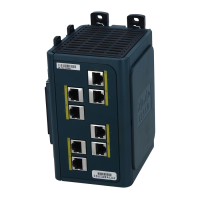855
Configuring IP Unicast Routing
Configuring BGP
3. Prefer the route with the highest local preference. Local preference is part of the routing update and exchanged
among routers in the same AS. The default value of the local preference attribute is 100. You can set local preference
by using the bgp default local-preference router configuration command or by using a route map.
4. Prefer the route that was originated by BGP running on the local router.
5. Prefer the route with the shortest AS path.
6. Prefer the route with the lowest origin type. An interior route or IGP is lower than a route learned by EGP, and an
EGP-learned route is lower than one of unknown origin or learned in another way.
7. Prefer the route with the lowest multi-exit discriminator (MED) metric attribute if the neighboring AS is the same for
all routes considered. You can configure the MED by using route maps or by using the default-metric router
configuration command. When an update is sent to an IBGP peer, the MED is included.
8. Prefer the external (EBGP) path over the internal (IBGP) path.
9. Prefer the route that can be reached through the closest IGP neighbor (the lowest IGP metric). This means that the
router will prefer the shortest internal path within the AS to reach the destination (the shortest path to the BGP
next-hop).
10. If these conditions are all true, insert the route for this path into the IP routing table:
• Both the best route and this route are external.
• Both the best route and this route are from the same neighboring autonomous system.
• Maximum-paths is enabled.
11. If multipath is not enabled, prefer the route with the lowest IP address value for the BGP router ID. The router ID is
usually the highest IP address on the router or the loopback (virtual) address, but might be implementation-specific.
BEFORE YOU BEGIN
Enable BGP routing as described in the Enabling BGP Routing, page 850.

